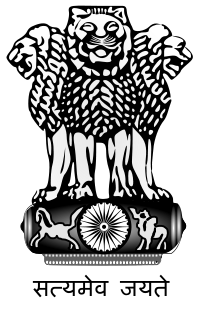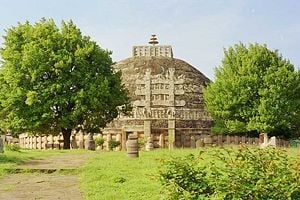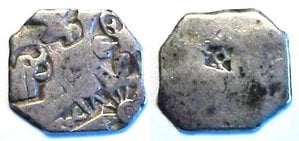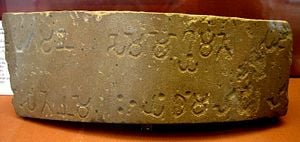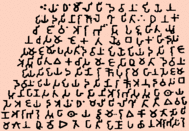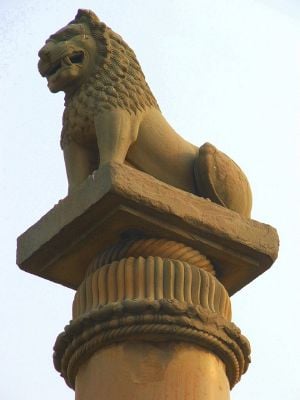Ashoka
Ashoka the Great (304 B.C.E. - 232 B.C.E.; also known as Asoka, Sanskrit: अशोक, Aśoka; pronounced Ashok, even though there is an 'a' at the end) was the ruler of the Maurya Empire from 273 B.C.E. to 232 B.C.E. After a number of military conquests, Ashoka reigned over most of South Asia and beyond, from present day Afghanistan in the north to Bengal in the east, and as far south as Mysore. An early supporter of Buddhism, Ashoka established monuments marking several significant sites in the life of Shakyamuni Buddha, and according to Buddhist tradition was closely involved in the preservation and transmission of Buddhism.
The name ‘Ashoka’ translates as “without sorrow” in Sanskrit. Ashoka was the first ruler of ancient Bharata (India), after the famed Mahabharata rulers, to unify such a vast territory under his empire, which in retrospect exceeds the boundaries of the present-day India.
The British author H. G. Wells (1866-1946) wrote of Ashoka: "In the history of the world there have been thousands of kings and emperors who called themselves 'Their Highnesses', 'Their Majesties' and 'Their Exalted Majesties' and so on. They shone for a brief moment, and as quickly disappeared. But Ashoka shines and shines brightly like a bright star, even unto this day" (1922).
Ashoka renounced violence and introduced a policy that established welfare as a right for all citizens; he promoted religious tolerance and core universal values including respect for all life, for parents, for teachers and the importance of spiritual awareness. He combined inner with outer morality and wanted to establish a more just and spiritual society. Ashoka’s concern for animals and for the environment—as well as for the disadvantaged and for prisoners—expressed itself in practical welfare provisions. In Ashoka’s opinion, justice had to be seen to be done.
Ashoka is revered as a hero by many; although, like other rulers, his own early career caused the death of thousands—many by his own hand—including his own siblings. H. G. Wells’ tribute, however, accurately expresses a fair assessment of Ashoka’s enduring and valuable legacy, which is consistent with Wells’ own deeply held conviction that our true nationality is humankind. Ashoka's reign, said Wells, “for eight-and-twenty years was one of the brightest interludes in the troubled history of mankind.”
The transformation of character and morals that Ashoka underwent serves as testimony to the degree that such change for the good is possible. Cruelty, jealousy, and power for power's sake are not character traits that are set in stone, and human personality can undergo radical transformation.
Historical Sources
Information about the life and reign of Ashoka comes primarily from a relatively small number of Buddhist sources. In particular, the two Pāli chronicles of Sri Lanka (the Dipavamsa and Mahavamsa) provide most of the currently known information about Ashoka. These Therevadin (School of the Elders) texts date from the fifth century C.E. and emphasize Ashoka's role in sending Buddhist missionaries far and wide, including his own son and daughters to Sri Lanka. Additional information is contributed by the Edicts of Ashoka, whose authorship was finally attributed to the Ashoka of Buddhist legend after the discovery of dynastic lists that gave the name used in the edicts (Piyadasi, meaning “good looking” or “favored by the Gods”) as a title or additional name of Ashoka Mauriya.
When James Princep (1799-1840), a British civil servant in India who also was Secretary of the Asiatic Society of Bengal, first deciphered one of the inscriptions in 1837, he thought they referred to an unknown king named Piyadasi. It was as late as 1915 that the identification with Ashoka (as suspected earlier) was proven when another inscription clearly bearing Ashoka's name was discovered. Another account, not always identical with the Pali version, is found in an earlier text the Ashokaavadaana (“Story of Ashoka”), a first-century C.E. Sanskrit work that was twice translated into Chinese: the A-yu wang chuan (c. 300 C.E.) and the A-yu wang ching (c. 500 C.E.). These texts stress Ashoka's role in encouraging lay Buddhism (and therefore seems to represent Mahayana interests) and also explores his relationship with the monastic community (the sangha). Its account of Ashoka's conversion (see below) is also different from the Pali version. Mahayana (Greater Vehicle) Buddhism gives more scope to lay participation than does the School of the Elders, for which the full-time ascetic life of a Bhikkhu is the ideal.
Later scholars have tended to question the degree to which Ashoka identified himself fully with the Buddhist tradition. The only sources of information not attributable to Buddhist sources—the Ashokan edicts—make only a few direct references to Buddhism, despite many references to the concept of dhamma (Pali) (Sanskrit: dharma). Some interpreters have seen this as an indication that Ashoka was attempting to craft an inclusive, poly-religious civil religion for his empire that was centered on the concept of dharma as a positive moral force, but which did not embrace or advocate any particular philosophy attributable to the religious movements of Ashoka's age (such as the Jains, Buddhists, orthodox Brahmanists (see Hinduism, and Ajivikas). Others point out that his aim was to inform ordinary people of the reforms he was instituting, and to encourage them to live more moral and spiritually aware lives. He deliberately used simple language, and had no interest or purpose in delinetaing complex Buddhist philosophy. His commitment to Buddhist was shown by his convening the third Buddhist Council in 250 B.C.E. with the aim of reconciling different schools of thought.
Most likely, the complex religious environment of the age would have required careful diplomatic management in order to avoid provoking religious unrest. Modern scholars and adherents to the traditional Buddhist perspective both tend to agree that Ashoka's rule was marked by tolerance towards a number of religious faiths.
Early life
Ashoka was the son of the Mauryan emperor Bindusara by a relatively lower ranked queen known as Dharma. Ashoka had several elder siblings and just one younger sibling, Vitthashoka. Because of his exemplary intellect and warrior skills, he is said to have been the favorite of his grandfather, Chandragupta Maurya, who founded the dynasty in response to the need for greater unity among the previously independent city states of India following Alexander the Great's invasion of 327 B.C.E. The empire reached its zenith during Ashoka's rule. According to legend, Ashoka recovered his grandfather's sword after Chandragupta Maurya cast it away before embarking on life as a Jain ascetic.
Rise to power
Developing into an impeccable warrior general and a shrewd statesman, Ashoka went on to command several regiments of the Mauryan army. His growing popularity across the empire made his elder brothers wary of his chances of being favored by Bindusara to become the next emperor. The eldest of them, Prince Susima, the traditional heir to the throne, persuaded Bindusara to send Ashoka to quell an uprising in the city of Taxila in the northwest province of Sindh, of which Prince Susima was governor. Taxila was a highly volatile place because of the warlike Indo-Greek population and mismanagement by Susima himself. Different militias had formed, causing unrest. Ashoka complied with his father’s request and left for the troubled area. As news of Ashoka's visit with his army trickled in, the revolting militias welcomed him and the uprising ended without a fight (the province revolted once more during the rule of Ashoka, but this time the uprising was crushed with an iron fist).
Ashoka's success made his stepbrothers more wary of his intentions of becoming the emperor, and more pressure from Susima led Bindusara to send Ashoka into exile. He went into Kalinga (Orissa) and stayed there incognito. There he met a fisherwoman named Kaurwaki, with whom he fell in love; recently found inscriptions indicate that she went on to become his second or third queen.
Meanwhile, there was again a violent uprising in Ujjain. Emperor Bindusara summoned Ashoka back after an exile of two years. Ashoka went into Ujjain and was injured in the ensuing battle, but his generals quelled the uprising. Ashoka was treated in hiding so that loyalists of the Susima group could not harm him. He was treated by Buddhist monks (Bhikkhus) and nuns (bhikkunis). This is where he first learned the teachings of Buddha, and it is also where he met Devi, who was his personal nurse and the daughter of a merchant from adjacent Vidisha. After recovering, he married her. It was quite unacceptable to Bindusara that one of his sons should marry a Buddhist, so he did not allow Ashoka to stay in Pataliputra and instead sent him back to Ujjain, this time as provincial governor. Many regarded Buddhism’s rejection of class and caste as socially dangerous, and its denial of the authority and role of the Brahmans (the highest class in Hindu society) also undermined the social system of the time.
The following year passed quite peacefully for Ashoka, and Devi was about to deliver his first child. In the meantime, Emperor Bindusara died. As the news of the unborn heir to the throne spread, Prince Susima planned the execution of the unborn child; however, the assassin who came to kill Devi and her child killed his mother instead. As the folklore goes, in a fit of rage, Prince Ashoka attacked Pataliputra (modern day Patna), and beheaded all his brothers, including Susima, and threw their bodies in a well in Pataliputra. At that stage of his life, many called him “Chanda Ashoka” (meaning “murderer and heartless Ashoka”).
After ascending the throne, Ashoka expanded his empire significantly over the next eight years. The empire grew from the present-day boundaries of Bangladesh and the state of Assam in India in the east to the territory of present-day Iran and Afghanistan in the west; from the Palmir Knots in the north to the almost peninsular part of southern India. This would be the greatest geographical expansion of the Mauryan Empire and one that has arguably remained unmatched in Indian history.
Conquest of Kalinga
While the early part of Ashoka's reign was apparently quite bloodthirsty, he became a follower of the Buddha's teaching after his conquest of Kalinga, on the east coast of India in the present-day state of Orissa. Kalinga was a state that prided itself on its sovereignty and democracy; with its monarchical-cum-parliamentary democracy, it was quite an exception in ancient Bharata (India), as there existed the concept of Rajdharma, meaning the duty of the rulers, which was intrinsically entwined with the concept of bravery and Kshatriya dharma (the duty of the warrior class, expounded by Krishna in the Bhagavad Gita).
The pretext for the start of the Kalinga War (265 B.C.E. or 263 B.C.E.) is uncertain. One of Susima's brothers might have fled to Kalinga and found official refuge there. This enraged Ashoka immensely, and he was advised by his ministers to attack Kalinga for this act of treachery. Ashoka then asked Kalinga's royalty to submit before his supremacy. When they defied this diktat, Ashoka sent one of his generals to Kalinga to make them submit.
The general and his forces were, however, completely routed through the skilled tactics of Kalinga's commander-in-chief. Ashoka, baffled at this defeat, attacked with the greatest invasion ever recorded in Indian history until then. Kalinga put up a stiff resistance, but was no match for Ashoka's brutal strength. The whole of Kalinga was plundered and destroyed: Ashoka's later edicts say that about 100,000 people were killed on the Kalinga side along with ten thousand from Ashoka's army; thousands of men and women were deported. At the time, Ashoka possessed the largest standing army of his day—600,000 infantry, 30,000 cavalry, and nine thousand war elephants.
Conversion to Buddhism
The Pali Version
As the legend goes, one day after the war was over, Ashoka ventured out to roam the city and all he could see were burnt houses and scattered corpses. This sight made him sick and he cried the famous quotation, "What have I done?" The brutality of the conquest led him to adopt Buddhism and he used his position to propagate the relatively new philosophy far and wide, sending missionaries as far as ancient Rome and to Alexandria in Egypt. The fact that Buddhist missionaries reached Egypt has even led to speculation that similarity between Jesus' teaching and Buddha's may be due to Jesus' having encountered these monks (see discussion in Bennett 2001, 67-68; 207-208; 322; 339-340). It has been suggested that the pre-Christian ascetics, known as the Therapeutae derived their name from Therevada. From that point Ashoka, who had been described as "the cruel Ashoka" (Chandashoka), started to be described as "the pious Ashoka" (Dharmashoka). He made Buddhism his state religion around 260 B.C.E. He propagated the Vibhajyavada school of Buddhism (from Vibhaajja, “analysis”; and vada, the precursor of Therevada Buddhism) discussion and preached it within his domain and worldwide from about 250 B.C.E. Some sources indicate that he had actually called himself a Buddhist two years before the war.
Ashoka's New Imperial Policy
Emperor Ashoka undoubtedly has to be credited with the first serious attempt to develop a Buddhist polity, this putting into practice the Buddha's own advice on kingship and government contained in the Dasa Raja Dharma, including the following ten precepts:
| Buddha's ten precepts |
| * be liberal and avoid selfishness, |
| * maintain a high moral character, |
| * be prepared to sacrifice one's own pleasure for the well-being of the subjects, |
| * be honest and maintain absolute integrity, |
| * be kind and gentle, |
| * lead a simple life for the subjects to emulate, |
| * be free from hatred of any kind, |
| * exercise non-violence, |
| * practice patience, and |
| * respect public opinion to promote peace and harmony. |
Ashoka published 14 edicts, as the basis on his new policy. These were:
- no living being were to be slaughtered or sacrificed.
- humans and animals are to be provided medical care throughout his territory.
- every five years his monks would tour the empire teaching the dharma.
- all should respect parents, priests and monks
- prisoners must be humanely treated.
- concers regarding the welfare of his people must be reported to him at all times no matter where he is or what he is doing.
- since all religions desire self-control and purity of heart, all are welcome.
- he prefers to give to monks and Brahmans and to the needy than to receive gifts from others.
- reverence for the dharma and a proper attitude towards teachers is better than marriage or other worldly celebrations.
- glory and fame count for nothing if his people do not repect the dharma.
- giving the dharma to others is the best gift anyone can have.
- Whoever praises his own religion, due to excessive devotion, and condemns others with the thought "Let me glorify my own religion," only harms his own religion. Therefore contact (between religions) is good.
- conquest by the dharma is superior to conquest by force but if conquest by force is carried out, it should be 'forbearance and light punishment'.
- he has written his edicts so that people might act in accordance with them (summary of the 14 major rock edicts based on Dhammika's translation, 1993).
Ashoka replaced conquest by force with what he called “conquest by righteousness” (dhammavijaya). He was possibly the first monarch to renounce violence, yet he remained a powerful and influential king, although the empire did decline after his death.
Propagation of Buddhism
Ashoka is mainly remembered in the ancient texts as a patron of Buddhist missionary endeavor. His son Venerable Mahinda and daughter Sanghamitta, a Bhikkuni (whose name means "friend of the Sangha"), were also prominent in this cause, establishing Buddhism in Ceylon (now Sri Lanka) and taking copies of the Pali canon of Buddhist scripture (the Tipitaka) with them, which was formalized at the third Buddhist Council convened by Ashoka. Ashoka built thousands of stupas and Viharas (monasteries/temples) for Buddhist followers. Some of his missionary monks may have been Greek. The Stupas of Sanchi are world famous and the stupa named “Sanchi Stupa 1” was built by Emperor Ashoka (see photo).
During the remaining portion of Ashoka's reign, he pursued an official policy of nonviolence (ahimsa). Wildlife became protected by the king's law against sport hunting and branding; even the unnecessary slaughter or mutilation of animals was immediately abolished. Limited hunting was permitted for consumption reasons, but Ashoka also promoted the concept of vegetarianism. Ashoka also showed mercy to those imprisoned, allowing them outside one day each year. He attempted to raise the professional ambition of the common man by building universities for study (including provisions for women to study) and water transit and irrigation systems for trade and agriculture. He treated his subjects as equals, regardless of their religion, political leanings, or caste. The kingdoms surrounding his, so easily overthrown, were instead made to be well-respected allies.
Ashoka's role in helping to spread Buddhism cannot be underestimated. Bhikkunis in Sri Lanka today trace their lineage right back to Ashoka's daughter and to the retinue of nuns who traveled to Sri Lanka with her. Although the order had a thousand-year absence in Sri Lanka, it was preserved in Korea and Japan and re-introduced into Sri Lanka in the last century. Sri Lanka remains one of the most important Buddhist societies today and a center of Buddhist scholarship. Had Ashoka not helped to spread Buddhism beyond India, it may not have survived, as it was largely disappearing from India (until re-introduced in the modern period) in the eleventh century C.E. (with the exception of the area of East Bengal bordering on Burma). Instead, it spread to China, Japan and beyond. Origen refers to Buddhist missionaries reaching England. Buddhism may not have reached China until the first century C.E., but there are stories of one of Ashoka's missionaries visiting China. The revival of interest in Buddhism in India is also attributable to Ashoka, since it was the rediscovery of his edicts that helped to stimulate interest.
Ashoka is acclaimed for constructing hospitals for animals and renovating major roads throughout India. After his change of heart, Ashoka came to be known as Dhammashoka (Sanskrit, meaning “Ashoka, the follower of Dharma”). Ashoka defined the main principles of dharma (dhamma) as nonviolence, tolerance of all sects and opinions, obedience to parents, respect for the Brahmans and other religious teachers and priests, liberality towards friends, humane treatment of servants, and generosity towards all. These principles suggest a general ethic of behavior to which no religious or social group could object. Indeed, from his twelfth edict, Ashoka appears to have pioneered not only inter-religious dialogue but also the concept that all religions share common truths and values.
Some critics say that Ashoka was afraid of more wars, but among his neighbors, including the Seleucid Empire and the Greco-Bactrian kingdom established by Diodotus I, none could match his strength. He was a contemporary of both Antiochus I Soter and his successor Antiochus II Theos of the Seleucid dynasty as well as Diodotus I and his son Diodotus II of the Greco-Bactrian kingdom. His inscriptions and edicts demonstrate that he was familiar with the Hellenic world (some were written in Greek) but he was never in awe of it. His edicts, which talk of friendly relations, give the names of both Antiochus of the Seleucid Empire and Ptolemy III of Egypt. The fame of the Mauryan Empire was widespread from the time that Ashoka's grandfather Chandragupta Maurya defeated Seleucus Nicator, the founder of the Seleucid Dynasty. Some of the information we have on Mauryan history is from the work of Greek historians and writers. As a result of Alexander the Great's imperial and cultural project, the world of India and the Hellenic world were now linked—and to a certain degree, shared a common view of the wider world both inhabited.
The Pillars of Ashoka at Sarnath are the most popular of the relics left by Ashoka. Made of sandstone, these pillars record the visit of the emperor to Sarnath, in the third century B.C.E.. In translating these monuments, historians have learned the bulk of what is assumed to have been true fact of the Mauryan Empire. It is difficult to determine whether certain events ever happened, but the stone etchings depict clearly how Ashoka wanted to be thought of and how he wanted to be remembered. Most of the pillars on which his edicts were inscribed are between 40 and 50 feet tall and weigh up to fifty tons each. They have been found in about thirty locations in modern-day India, Nepal, Pakistan, and Afghanistan.
Ashoka's own words as known from his edicts are: "All men are my children. I am like a father to them. As every father desires the good and the happiness of his children, I wish that all men should be happy always." Certainly, Ashoka's dharma was intended to be a polity around which all in his heterogeneous kingdom could unite, and it has something in common with Akbar the Great's sulh-i-kull policy of a later but not dissimilar time.
The Sanskrit Version
The conversion account contained in the Ashokaavadaana does not refer to the Battle of Kalinga and appears more mythical than the aforementioned account; however, it contains interesting details about Ashoka's practice of Buddhism. In this text, a Buddhist monk named Samudra appears at what he thought was a palace in Ashoka's capital, but was in fact a new building dedicated to the “art of execution,” “asking for alms” only to become potential victim of a strange transaction that allowed the palace's builder, Chandagirika, to kill whoever was first to step through the door. This young man had always delighted in torturing and killing and had already callously dispatched his own parents. Samudra was the unfortunate person. Chandagirika agreed to a seven-day delay when the monk, who feared death, begged him for mercy. Meanwhile, a youth and one of the women of the royal household caused some offense to Chandagirika, who ordered their execution. He then had their bodies “ground ... with pestles in an iron mortar before Samudra.” Witnessing this horrible execution, Samudra suddenly realized the truth of the Buddha's teaching of impermanence and gained enlightenment, becoming an arhat (liberated being). The next morning, the time for his own execution arrived but he was calm and fearless, detached from his physical self. He said to Chandagirika, “True my night of ignorance has cleared and the sun of my good fortune is at its height. You may do as you wish, my friend.” The executioner was quite unmoved, and threw Samudra into a cauldron of water and blood. However, as hard as Chandagirika tried to light a fire underneath the cauldron, he could not do so. Looking into the cauldron, he was amazed to see Samudra calmly sat on a lotus. He immediately went to find Ashoka, so that he too could see this miracle, which hundreds of people also came to see. Samudra realized that the time was ready for Ashoka to become a Buddhist, which the text explains:
- Miraculously, Samudra floated up in the air and stunned the monarch.
- For from half his body water poured down;
- from the other half fire blazed forth;
- Raining and flaming, he shone in the sky.
Ashoka folded his hands and asked to be initiated into the mysteries of the Dharma. Thus, Ashoka converted to Buddhism, becoming a lay-devotee (upasaka). Samudra also informed Ashoka that the Buddha had predicted that a king would arise who would build 84,000 stupas to contain his bodily relics, but instead the emperor had built a Palace of Execution. Ashoka then begged for forgiveness, and took the three “refuges” by which one becomes a Buddhist (refuge in the Buddha, in the dharma and in the sangha). He also promised to build stupas to house the sacred relics. Then, the monk vanished. As Ashoka was about to leave himself, his executioner challenged him that his boon had not been granted and that he still had the right to execute the first person who had entered the Palace. Surprised that his servant apparently intended to execute his king, Ashoka replied that since Chandagirika had in fact entered before him, it should be him who dies. Chandagirika was duly executed (he was not last man to be killed by Ashoka's orders, but later Ashoka forbade all executions) and the palace of horrors (described as paradisal hell in the text) was destroyed.
The text continues with the story of how Ashoka recovered the relics from eight previously built stupas, and constructed the new ones as he had promised. On one occasion, in order to earn some merit (to recover from some sort of ailment) he traveled his realm incognito as a mendicant, experiencing the life of a monk. The phrase yam me samghe upeti, which translates as “going to the Sangha,” has led some scholars to claim that Ashoka became a full-time mendicant, but it probably implies that he visited and spent time listening to the monks. It is said that Ashoka venerated monks, which his retinue thought inappropriate for a king. He donated generously to the Sangha. Both conversion stories record that Ashoka underwent a change of heart that involved repudiation of slaughter and a new commitment to peace, and to the precepts and teachings of Buddhism.
Death and legacy
Emperor Ashoka ruled for an estimated forty years, and after his death, the Mauryan dynasty lasted just fifty more years. Ashoka had many wives and children, but their names are unknown except for a small number. Mahinda and Sanghamitta were twins born by his first wife, Devi, in the city of Ujjain. He had entrusted to them the job of making his state religion, Buddhism, more popular across the known and the unknown world. They went to Sri Lanka and converted the king, Devanampiva Tissa, the queen, and their people to Buddhism. Some rare records speak of a successor of Ashoka named Kunal, who was his son from his last wife, but his rule did not last long after Ashoka's death.
The reign of Emperor Ashoka Maurya could easily have disappeared into history as the ages passed by, and would have, if he had not left behind a record of his trials. The testimony of this wise king was discovered in the form of magnificently sculpted pillars and boulders with a variety of actions and teachings he wished to be published etched into the stone. What Ashoka left behind was the first written language in India since the ancient city of Harappa. Rather than Sanskrit, the language used for inscription was the current spoken form called Prakrit.
In the year 185 B.C.E., about fifty years after Ashoka's death, the last Mauryan ruler, Brhadrata, was brutally murdered by the commander-in-chief of the Mauryan armed forces, Pusyamitra Sunga, while he was taking the Guard of Honor of his forces. Pusyamitra Sunga founded the Sunga dynasty (185 B.C.E.-78 B.C.E.) and ruled just a fragmented part of the Mauryan Empire. The empire's decline is mainly attributable to the weak leadership that succeeded Ashoka's rule, but several other factors also contributed. These include the deskilling of the military, which lost their jobs under Ashoka's policy and were subsequently unable to offer adequate defense. The large administration required strong leadership and when this was not forthcoming, provinces tended to assert independence from the center. Also, the Brahman priests had been sidelined by Ashoka's Buddhist policy but after his death worked to undermine this, which encouraged civil war. Ashoka's time had been one of unification, bringing small kingdoms together; it was followed by a time of fragmentation. Not until some two thousand years later under Akbar the Great and his great-grandson Aurangzeb would as large a portion of the subcontinent again be united under a single ruler.
When India gained independence from the British Empire it symbolically adopted Ashoka's emblem for its own, placing the dharma wheel that crowned his many columns on the flag of India of the newly independent state. Ashoka's non-violence was also revived during the independence struggle against the British, by the nationalist leader and Hindu philosopher Mahatma Gandhi.
In addition to his legacy as probably the first Buddhist king and as one of the pioneers of an alternative approach to governance, Ashoka was an efficient administrator. His empire was divided into five provinces, with capitals at Taxila, Ujjain, Tosali, Suvarnagiri and Patilaputra. A kumara (prince) governed each province. These were sub-divided into groups of several villages. Each village was headed by a Gramika. At the center, ministers of state (mantris) dealt with the judiciary matters and taxation. Ashoka issued Sasanasad (ordinances). However, he appears to have listened to people's concerns and consulted not only his ministers but common people as well. He was very concerned that justice was fair, and he made the system much more open than it had been before. Death sentences were commuted. Time was allowed for appeals. He wrote:
I even go this far, to grant a three-day stay for those in prison who have been tried and sentenced to death. During this time their relatives can make appeals to have the prisoners' lives spared. If there is none to appeal on their behalf, the prisoners can give gifts in order to make merit for the next world, or observe fasts." (Pillar Edict Nb4; S. Dhammika)
Public funds were spent on major projects, including agriculture to feed the poor, to dig wells, and also to plant trees so that people could benefit from the shade they gave in the hottest conditions. Art and culture flourished (both show signs of Greek and Persian influence) and both were conscripted to help the spread of Buddhism. He provided free medical care for people and animals. From 399 to 414 C.E., the Chinese scholar Fa-Hien traveled to India in search of great Buddhist books of discipline. He reported seeing works of art, rock cut caves, palaces, and exemplary buildings from Ashoka's period. There appears to have been a sophisticated civil service. A characteristic of Mauryan art was the mirror-like finish to the pillars, which has survived centuries of exposure to wind and sun.
Ashoka combined personal and state ethics and tried to bridge divides in his multi-cultural empire. He wrote, "You Are True to Your Own Beliefs If You Accord Kindly Treatment to Adherents of Other Faiths. You Harm Your own Religion by Harassing Followers of Other Creeds" (Emperor Ashoka, Rock Text 3). He believed that his code of reverence and compassion was based on universal values. His fourteen-point code aimed to hold inner morality and outer action in harmony. He turned away from the kingship of power, compulsion and self-interest, and dared to believe that he could construct a different kind of kingdom based on causing no one harm. It has been suggested that no greater or better kingdom has yet been known among men. In Kalinga Rock Edict One, he instructed his judicial officers, warning them that they would not be promoted unless they furthered his desire:
All men are my children. What I desire for my own children, and I desire their welfare and happiness both in this world and the next, that I desire for all men. You do not understand to what extent I desire this, and if some of you do understand, you do not understand the full extent of my desire.
Indian writer Gita Mehta (1995) suggests that contemporary nuclear-bomb possessing India can profitably emulate Ashoka's example:
Peaceful coexistence, religious tolerance, social welfare, ecological responsibility, education, impartial justice, respect for all living things-is it possible that these were practiced over such a huge land mass occupied by so many millions of people two-and-a-half millennia ago? And if they were possible then, why can't they be practiced now? The question is still asked in modern India. (25)
ReferencesISBN links support NWE through referral fees
- Bennett, Clinton. In Search of Jesus: Insider and Outsider Images. New York and London: Continuum, 2001. ISBN 0826449166
- Mehta, Gita. “Ashoka: Beloved of the Gods.” Tricycle: The Buddhist Review Winter 1998: 21-25.
- Strong, John S. Legend of King Asoka. Delhi: Motilal Banarsidass. Second edition, 2002. ISBN 8120806166
- Swearer, Donald. Buddhism and Society in Southeast Asia. Chambersburg, PA: Anima Books, 1981. ISBN 0890120234.
- Wells, H. G. “Asoka” (chapter 29). A Short History of the World. New York: Macmillan, 1922.
External links
All links retrieved August 18, 2023.
Credits
New World Encyclopedia writers and editors rewrote and completed the Wikipedia article in accordance with New World Encyclopedia standards. This article abides by terms of the Creative Commons CC-by-sa 3.0 License (CC-by-sa), which may be used and disseminated with proper attribution. Credit is due under the terms of this license that can reference both the New World Encyclopedia contributors and the selfless volunteer contributors of the Wikimedia Foundation. To cite this article click here for a list of acceptable citing formats.The history of earlier contributions by wikipedians is accessible to researchers here:
The history of this article since it was imported to New World Encyclopedia:
Note: Some restrictions may apply to use of individual images which are separately licensed.
